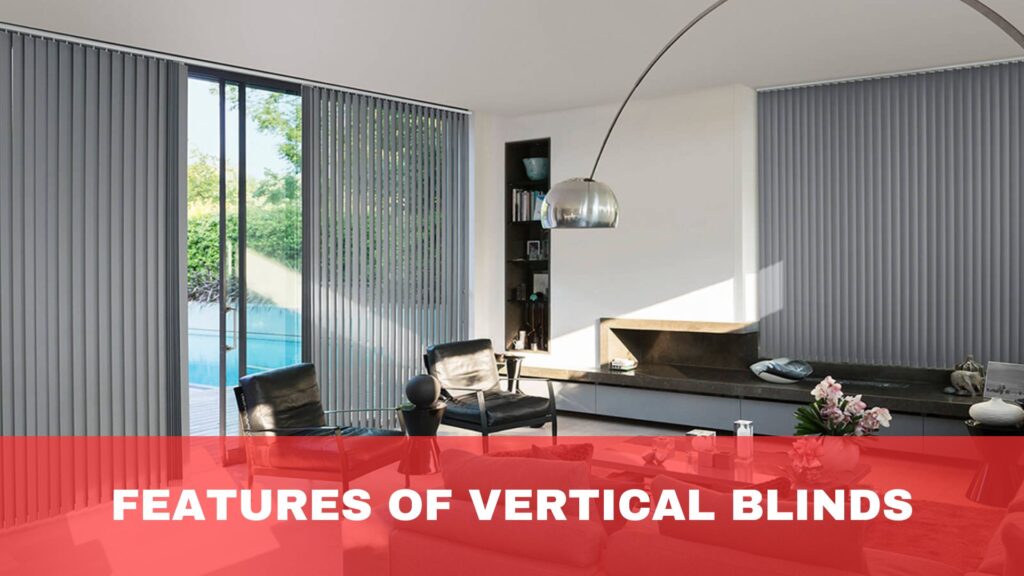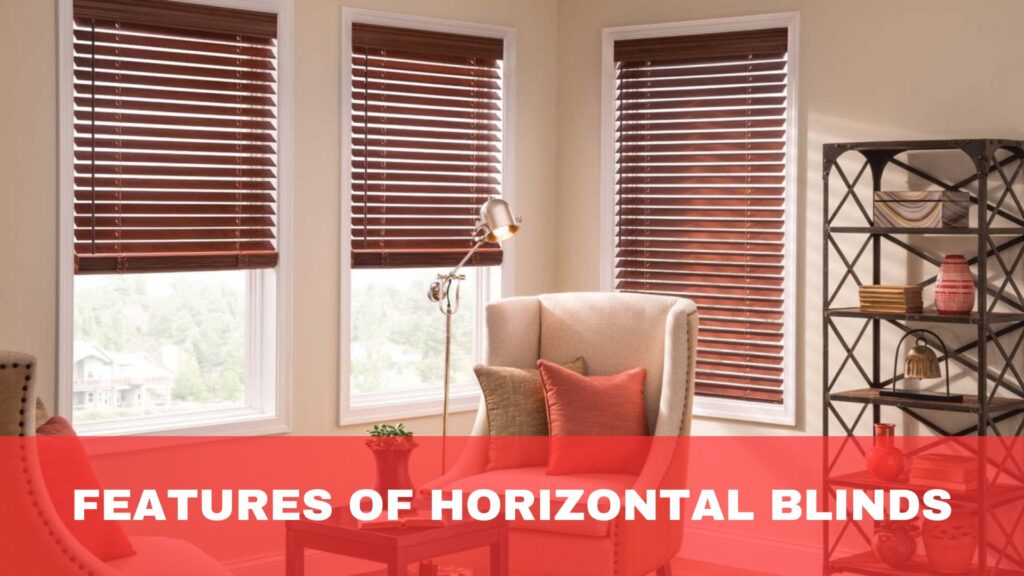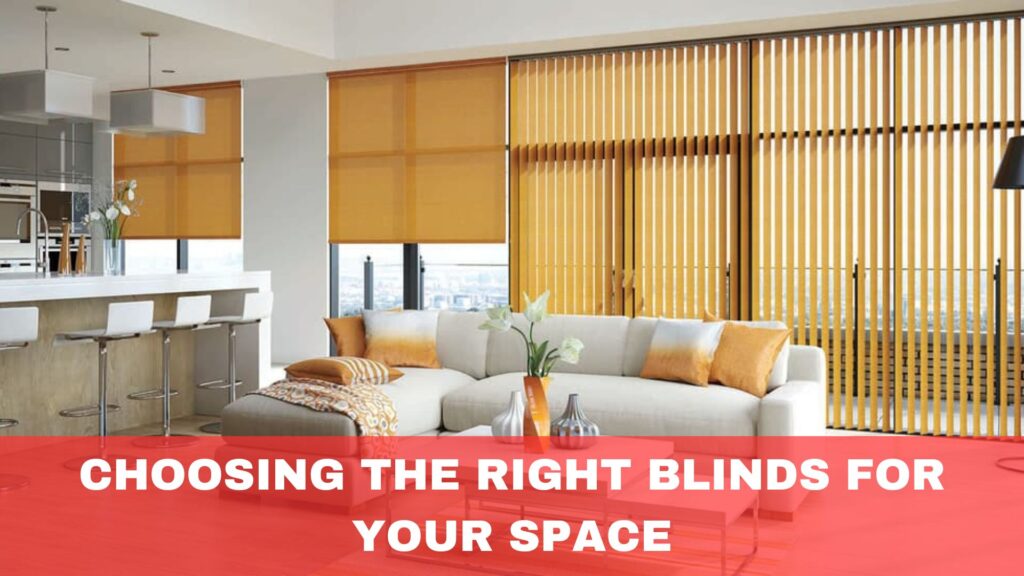Struggling to choose between vertical and horizontal blinds for your home?
With so many options and factors, making the right decision can feel overwhelming. The wrong choice can affect your room’s aesthetics, light control, and energy efficiency.
In this article, we’ll discuss the key differences, pros, and cons of vertical and horizontal blinds to help you make an informed choice that perfectly suits your needs and style.
Features of Vertical Blinds

1. Design and Functionality
Horizontal blinds are an excellent choice for small to medium-sized windows, making them ideal for bedrooms, bathrooms, and kitchens. They offer excellent control over light and privacy, as the slats can be tilted to block or allow light as needed. This makes them perfect for rooms where precise light management is essential.
Blinds are available in various materials, including wood, faux wood, aluminium, and vinyl, offering styles that complement any décor. Many blinds also feature insulating properties, helping to reduce energy costs by keeping rooms warmer in winter and cooler in summer.
These blinds are easy to operate and maintain, with many models featuring cordless options for added safety, especially in homes with children or pets. With their sleek appearance and practical benefits, horizontal blinds are a reliable and stylish solution for many window types.
2. Advantages
Blinds offer many advantages, making them a preferred window treatment for many homeowners. One of their primary benefits is the ability to control light and privacy precisely. By adjusting the angle of the slats, you can easily regulate the amount of light entering the room and maintain privacy without compromising natural illumination.
Blinds are available in various materials, such as wood, faux wood, aluminium, and vinyl, allowing you to select options that best match your interior décor and personal style. They are also highly durable, with many materials being resistant to moisture, making them suitable for high-humidity areas like kitchens and bathrooms.
Additionally, blinds are easy to clean and maintain, often requiring only a simple wipe with a damp cloth. Their sleek design and functional versatility make blinds an excellent choice for modern and traditional homes.
3. Disadvantages
While blinds offer many benefits, there are also some disadvantages to consider. One of the main drawbacks is that they can be challenging to clean, especially horizontal blinds, which tend to collect dust on each slat. Although vertical blinds are easier to maintain, they can be noisy, mainly when opening windows or doors.
Blinds also provide less insulation than window treatments like curtains, potentially affecting energy efficiency in extreme temperatures. Additionally, some materials, such as aluminium or vinyl, may bend or break over time, especially with frequent use.
The slats can become misaligned or damaged in high-traffic areas, affecting their appearance and functionality. It’s essential to weigh these potential issues against the benefits to ensure that blinds are the right choice for your needs and environment.
Features of Horizontal Blinds

1. Design and Functionality
Blinds offer a sleek and versatile design that can suit various interior styles. Vertical blinds consist of long slats that hang from a headrail and move side-to-side, making them ideal for large windows and sliding doors. This design allows for easy light and privacy control by tilting the slats or drawing them entirely to one side.
Horizontal blinds, on the other hand, feature slats that stack from top to bottom. They are perfect for smaller windows, providing excellent light control and a classic appearance. Both types come in various materials and colours, allowing you to match them with your existing décor.
Blinds’ functionality extends to their operation, with options for manual or motorised controls, adding convenience and modernity to their design. This flexibility in design and functionality makes blinds a practical choice for any room in your home.
2. Advantages
Blinds offer numerous advantages, making them a versatile and practical window treatment. They provide precise light control, allowing you to adjust the slats to let in just the right amount of natural light while maintaining privacy. This ability is ideal for rooms requiring illumination and seclusion, such as living rooms and offices.
Blinds are available in various materials, including wood, faux wood, aluminium, and vinyl, offering styles that complement any décor. Many blinds also feature insulating properties, helping to reduce energy costs by keeping rooms warmer in winter and cooler in summer.
Their durability and low maintenance requirements make them an economical choice over time, as they often need just a quick dusting to stay clean. With options for both manual and motorised operation, blinds combine functionality with convenience, enhancing your home’s comfort and aesthetic appeal.
3. Disadvantages
Understanding the disadvantages of each is crucial when choosing between vertical and horizontal blinds. Vertical blinds can be problematic for rooms with frequent traffic, as their panels may sway or get caught, potentially leading to wear and tear. They also offer less privacy when open, as gaps between panels can be noticeable.
On the other hand, horizontal blinds may not be ideal for tall windows or sliding doors, as their shorter slats can create uneven light distribution and obstruct the view. Additionally, horizontal blinds often require more cleaning due to their slats accumulating dust and debris more quickly.
Choosing the Right Blinds for Your Space

1. Room and Window Considerations
Selecting the right blinds involves assessing your room and window specifics. Vertical blinds are well-suited for large windows and sliding doors, as their design accommodates wide spans without obstructing movement. They are ideal for rooms with a more contemporary look and for spaces where privacy is less concerned.
Conversely, horizontal blinds are better for standard windows and smaller openings, providing a classic appearance and effective light control. They excel in rooms with varying window heights and offer precise adjustments for privacy and light. Consider the room’s purpose and window dimensions to ensure optimal function and aesthetic harmony.
2. Light and Privacy Needs

Consider how each affects light and privacy when choosing between vertical and horizontal blinds. Vertical blinds offer flexible light control, allowing you to adjust the panels to filter or block light while maintaining privacy. However, gaps between the panels can let light seep through when the blinds are closed.
Horizontal blinds provide more precise light control, as you can tilt the slats to direct light exactly where needed. They also offer better privacy, as the slats overlap and minimise gaps. Horizontal blinds might be the better option for rooms requiring maximum privacy and light management. In contrast, vertical blinds are suitable for spaces where light flexibility and ease of use are prioritised.
3. Design and Aesthetic Preferences
Design and aesthetic preferences play a significant role when selecting between vertical and horizontal blinds. Vertical blinds offer a sleek, modern look and can make a room appear taller, enhancing the sense of space.
They are ideal for contemporary interiors and large windows. In contrast, horizontal blinds provide a classic, timeless appearance that suits traditional and formal settings. Their slats can create a sense of depth and add texture to the decor.
Consider the overall style of your room:
Vertical blinds complement minimalist designs, while horizontal blinds blend well with more ornate or classic interiors. Your choice should align with the room’s aesthetic to achieve a cohesive and visually pleasing effect.
4. Budget Considerations
Budget plays a crucial role when choosing between vertical and horizontal blinds. Vertical blinds generally have a lower initial cost, making them a more economical choice for large windows and sliding doors. They are often more affordable due to their more straightforward design and ease of manufacturing.
Horizontal blinds can be more expensive, particularly those made from premium materials or with additional features. Their cost can increase based on slat material, size, and customisation. While the upfront cost might be higher, horizontal blinds often provide outstanding durability and better light control.
Assessing your budget alongside your long-term needs and preferences will help you select the blinds that offer the best value for your investment.
5. Maintenance and Durability

Maintenance and durability are key factors when evaluating vertical versus horizontal blinds. Vertical blinds typically require less frequent cleaning, as their design prevents dust from settling on the slats. However, the fabric panels can be prone to staining and may need occasional spot cleaning.
Conversely, horizontal blinds often gather dust on the slats, necessitating regular dusting or wiping to keep them clean. They are generally more durable, mainly when made from high-quality materials like aluminium or wood, which can withstand daily use better than some vertical options.
Consider the level of maintenance you’re willing to commit to and the durability needed based on the room’s usage to ensure you select blinds that meet both your practical and aesthetic requirements.
Conclusion
In conclusion, choosing between vertical and horizontal blinds hinges on your light control, privacy, and design needs. Evaluate your space and preferences carefully to make an informed decision.
For tailored advice and a wide selection of options, consult a professional to find the perfect blinds that enhance both function and style in your home.


